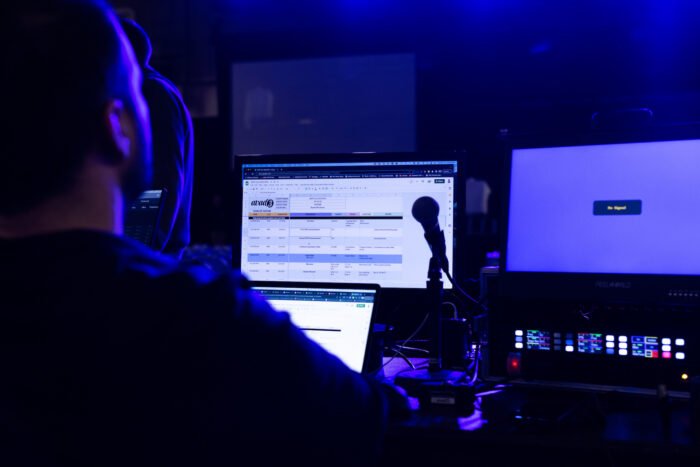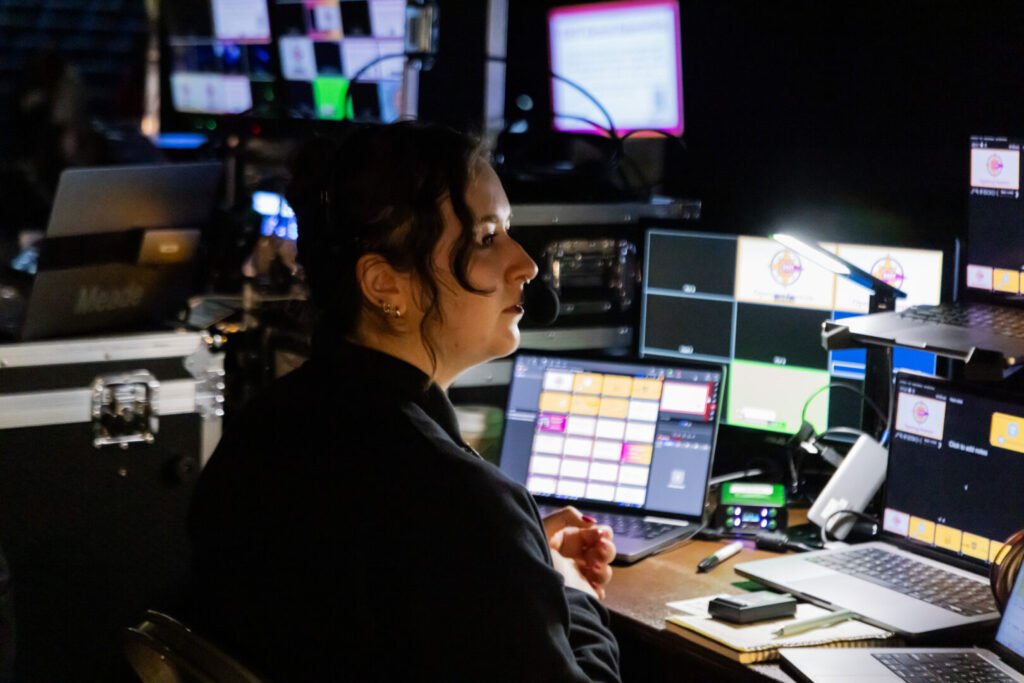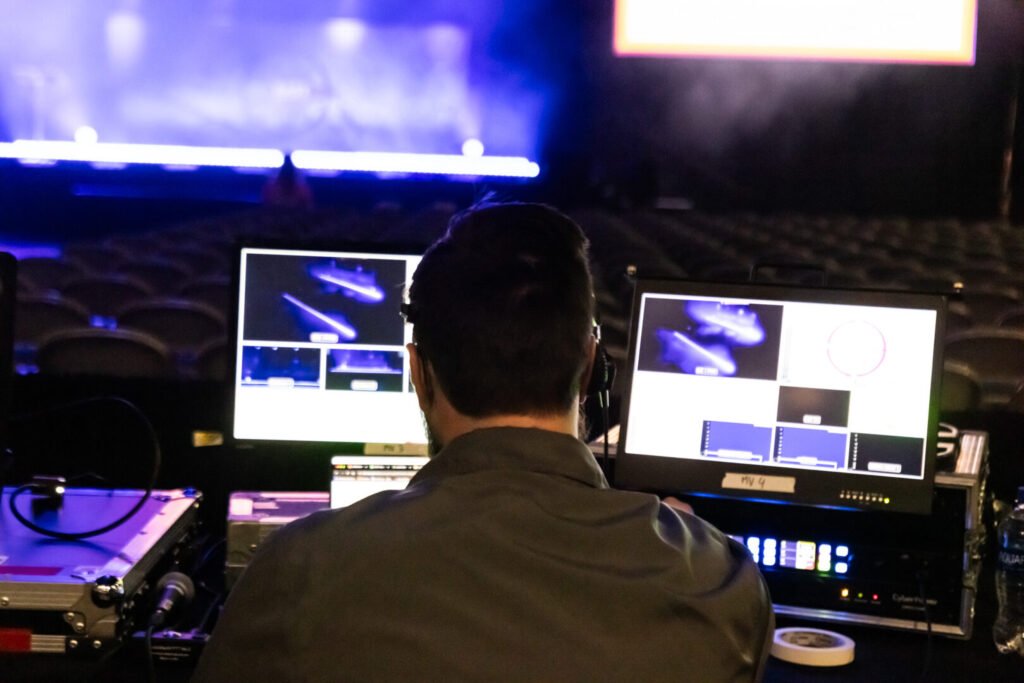It’s often difficult to feel involved at an event with thousands of people in attendance. Even when a presenter involves the audience, chances are you’ll be more of an observer than a participant. And while learning can absolutely happen in large groups, the methods and effectiveness are limited. This is why breakout sessions can be so essential to events. They can have different structures, sizes, and goals, but they all serve a common purpose: they increase the value of an event for attendees. Pulling this off often requires the expertise of an event production team, at avad3 We maintain control over every aspect of production, ensuring quality and reliability. We are a hands-on team committed to delivering exceptional results and seamlessly integrating ourselves into your project.
Let’s look at how this happens.

Photo by: avad3 Event Production, cozy breakout space at Walmart Marketplace Seller Summit – Las Vegas NV.
What are Breakout Sessions?
Basically, breakout sessions are smaller meetings that happen at designated times during a larger event. There are typically multiple breakout sessions happening at the same time, and attendees are either assigned a session to attend or are allowed to choose based on their needs and preferences. The aim of breakout sessions is to allow for greater participation and collaboration within a more intimate setting. Breakout sessions can be just as effective virtually as they are in person to boost engagement and productivity. If you’re interested in the photos you’re seeing in this article, check out the case study to the event we’re heavily featuring here
Photo by: avad3 Event Production, Team member makes adjustments in breakout room at Springdale Convention Center – Springdale AR.
Breakout Session Benefits
The benefits of breakout sessions are plentiful. People feel much more comfortable in smaller groups when being asked to participate in a discussion or activity. It’s a great opportunity to focus on a specific topic and invite detailed conversations. If attendees have been in large sessions, listening to speakers, a breakout session can provide a welcome break from the monotony that allows them to relax and refocus. Participants are much more likely to feel ownership over the training they’re receiving, or the work they’re doing, when they feel they’re a part of a small group that has come together purposefully, and it will enhance their engagement.

Photo by: avad3 Event Production, Team member behind camera in breakout room at EAST Con – Hot Springs AR.
Types of Breakout Sessions
Breakout sessions can have many outcomes, even within one session. Usually, though, the sessions are created with one of four main goals in mind:
– Collaboration These sessions serve to have a small group accomplish a task together. Maybe they are brainstorming, maybe they’re refining an idea. This is similar to the think tank concept. The way collaboration is achieved can depend on the size of the group, the time, and the task.
– Learning At large professional conferences, learning breakout sessions are a popular way to provide attendees with a range of opportunities to learn more in areas that specifically interest them. It allows a greater diversity of knowledge to be disseminated, by a range of presenters whose expertise varies. Each presenter has the freedom to present in the way that best suits them and the information they are passing along.
– Fun For people to work well as a team and be productive, it is essential that they get to know each other in a way that’s low pressure and enjoyable. There will always be people who think having fun isn’t important or helpful but- we’ll just say it- they’re wrong.
– Networking If attendees don’t get much face-to-face time or have never met, breakout sessions are an excellent opportunity for them to fix that. This can even work with online sessions, and it adds tremendous value to the event experience for those who participate.

Photo by: avad3 Event Production, Team member adjusts audio console in a breakout room at EAST Con.
Session Ideas
Once you know which type or types of breakout sessions you need, you can turn to choosing from a wide variety of options on how to structure them. Let’s look at some examples of what can happen in breakout sessions.
– Lightning Talks In a setting where education is the goal, it’s important to guard against overwhelming attendees. Lightning talks, where a presenter gives a focused, short talk on a particular topic, allows for a slice of knowledge to be presented in a way that keeps everyone’s attention and is manageable to ingest.
– Speed Networking Being surrounded by hundreds of your professional peers is an excellent opportunity, but creating connection can be difficult. A speed networking session gives participants the infrastructure they need to make new contacts quickly and efficiently.
– Games Yes, games. Fun can be tremendously effective at getting people engaged and energetic.
– Goal Setting This is a flexible process that can be used to allow attendees to make personal or professional goals, or even work together to brainstorm goals for a project or organization.
– Ask Me Anything (AMA) Popularized online but just as doable in person, these sessions allow a leader or noteworthy attendee to answer questions in a more casual setting. Doing this during a breakout session means more people will be able to actually ask their questions, and it will make the process feel more informal and intimate.
– Outdoor Activities Breakout sessions don’t have to happen in conference rooms or ballrooms. An outdoor session can bring a literal and figurative breath of fresh air to participants and allow them some movement. It’s a great opportunity for activities with a physical element.
– Open Mic Most people have something valuable to say if they’re given the chance. Open mic sessions can be fun and interesting but they can also be revelatory. It’s likely that your team has hidden strengths they’ve never had the opportunity to showcase. This gives them that opportunity.
– Drop-in Discussions This is a great option when participants are on the go. Hosting a drop-in discussion on a specific topic means people who would need to arrive late or leave early can still feel encouraged to attend and participate.

Photo by: avad3 Event Production, large breakout room at Walmart Marketplace Seller Summit – Las Vegas NV.
Planning & Execution
If you know breakout sessions will add value to your event, it’s important that you plan well and execute properly. First, set clear goals for each session as you plan. Make sure there isn’t redundancy and that you have a measurable way to know if the session was successful. When scheduling the sessions consider space layout, noise issues, and travel time for attendees. Even if the sessions are virtual, people need time to visit the bathroom and take a breath to refocus. Once the schedule is set, make sure participants are informed of all the important details.
For each session, consider the space. How should it be laid out? If it’s virtual, what format will work best? If you are grouping participants rather than having them choose what to attend, do
so thoughtfully.
Consider the range of experience, demographics, and personalities to create groups that will provide a variety of viewpoints and expertise. Make sure each room has all the materials and equipment it needs. Double check with a session’s presenter or moderator on this point since they’re the ones who will be running that particular show. Technology can enhance sessions in all kinds of ways, so look into what you have available and discuss the sessions and your options with your production company. Don’t forget to get event feedback specifically on the breakout sessions both from participants and facilitators, so you will know what worked and what could use improvement next time.

Photo by: avad3 Event Production, breakout room at Rewired – Bud Walton Arena.
Using Platforms
If your event has an online component or is entirely virtual, don’t think that breakout sessions can’t still happen and be valuable. Tools exist that make the process streamlined and smooth- products like Kaltura can help you manage your sessions with ease. They contain features like auto-assign for groups, digital whiteboards, and simplified screen sharing. You can also assign host controls for breakouts that allow multiple people to manage several sessions simultaneously.
Breakout sessions have been around for a long time, with good reason. They’ve proven effective at giving people a different, more intimate way to work and learn. They can be employed at large conferences, company meetings, and learning summits. The ways they can be used are as varied as the outcomes that can be achieved, and the evolution of technology has broadened capabilities even more. Breakout sessions are worth the planning work!





















